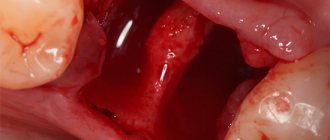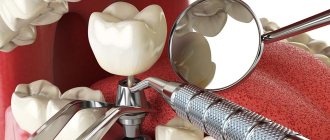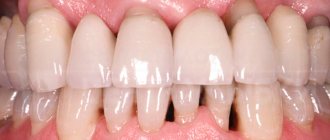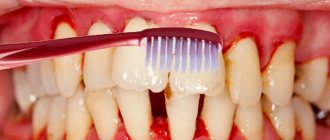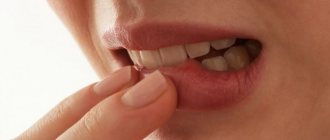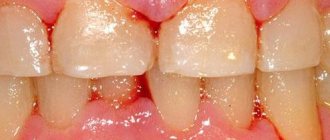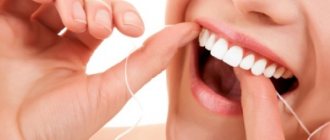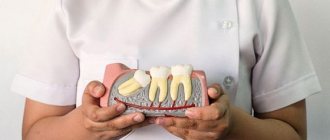Many patients imagine dental prosthetics as the installation of a system of crowns, which is placed in the coronal area and can fully replace natural teeth both externally and functionally. Dental implantation means that it first replaces the lost tooth root with an artificial one, which is embedded deep into the bone tissue. In addition, and few people know about this, in some cases, during prosthetics, another important component of such a design is installed. This component is artificial gum, the presence of which in the structure of the prosthesis is very often justified and necessary for one reason or another, which is described in detail below.
In what cases is gum grafting used?
Like any surgical operation, gum grafting when the roots are exposed has a number of indications:
- anomalies of the anatomical structure of teeth, periodontium, frenulum of the lips and jaws of a congenital nature;
- inflammatory diseases of the gums, accompanied by hypertrophy or atrophy of the mucous tissue (hypertrophic and atrophic gingivitis, periodontitis);
- periodontal disease;
- mechanical damage to the gums;
- orthopedic treatment;
- implantation;
- bad habits (pencil biting);
- consequences of mistakes after therapeutic dental treatment.
If the periodontal tissue rises above the coronal part of the tooth, or vice versa, covers the crown by ½ of its length, you must contact a dental surgeon for medical help. Your doctor will tell you how to grow gum on a tooth in a given situation.
Types and methods of gum augmentation
Gum surgery is divided into 3 main types:
- vestibuloplasty – plastic surgery performed for multiple gum recessions and exposure of dental roots;
- gingivoplasty – performed to restore the aesthetics of a smile (gummy or shark smile);
- periodontal excision – performed to reduce the load on emerging wisdom teeth.
The choice of gum grafting method depends on the cause of the change in periodontal tissue and the severity of the pathology. There are two ways of periodontal extension:
- plastic surgery using your own flap taken from the soft palate;
- use of a collagen matrix or barrier membrane.
Gum grafting from the palate is easy to perform, since no additional materials need to be used during grafting. The second method of extension is complicated by the use of artificial materials that are not reproduced by one’s own body. The rehabilitation period increases over time.
Types of prostheses
Depending on the goal pursued and the structural features of the patients’ jaw, there are several main types of artificial implants, such as:
Loose systems based on artificial gums. They are installed by gluing them to the gums with special compounds or by attaching them to healthy teeth. This design contains a soft imitation of gums and hard crowns.
Permanent dentures that do not contain artificial gums. For the most part, these are bridges and implants. The advantage of these dentures is that when installing them there is no need to grind down adjacent teeth.
Permanent structures with gum. Moreover, the aesthetic appearance of dentures that allow the installation of implants on bridges with artificial gums.
Gumplasty for tooth root exposure and recession
Some periodontal diseases are accompanied by exposure of dental roots and a decrease in the level of periodontium. Recession of the papillary marginal gum when the tooth root is exposed not only spoils the appearance of the smile, but is also a favorable condition for the occurrence of caries and its complications.
Unfortunately, it will not be possible to grow gums at home and hide the exposed root, so you need to contact a dental surgeon for dental help.
Exposed teeth can be a consequence of an incorrectly positioned frenulum on the child’s gum. Pathology occurs both in the lower teeth of the front row and in the upper incisors. Dental extensions will help to cope with this problem.
Frenumplasty is performed under local anesthesia in the vestibule of the mouth. After correction of the mucous bridges, the dentist performs gum plastic surgery when the roots are exposed using his own free graft.
Carrying out osteoplasty
In most cases, before undergoing surgery for recession, the patient is prescribed osteoplasty. This procedure is a treatment in which the doctor helps to change the incorrect alignment of bone tissue, which negatively affects a person’s appearance, his health, and the condition of his teeth.
Osteoplasty is recommended for patients who have the following problems with the oral cavity:
This procedure is performed surgically, its duration directly depends on the complexity of the patient’s problem. The operation is performed under anesthesia, which helps to eliminate any existing deficiencies in bone formation or change those that arose as a result of injury.
Indications and technique of flap surgery on the gums
Transplantation of flap tissue to the periodontal area has the following indications:
- pathological periodontal pockets more than 5 mm deep;
- inflammatory gum hypertrophy;
- moderate to severe periodontitis;
- periodontal disease;
- pathological crowding of teeth;
- increased bleeding;
- tooth mobility grades 2 and 3 according to Entin;
- significant lack of periodontal tissue;
- destruction of the jaw bones;
- exposure of dental roots.
Gum surgery makes it possible to preserve the health and function of teeth, as well as protect the periodontium from infection.
Under infiltration anesthesia, an incision is made in the area of exposed roots. The wound is cleaned of dead epithelial cells and other contaminants. The next stage of plastic surgery is taking a palatal flap. Epithelial tissue is transplanted into an area where gum tissue is deficient. The extension is completed by stitching the mucous membrane and the graft together.
After the gum transplant has achieved the desired result and the flap has fused with the periodontium, the suture material is removed.
Gum plastic surgery during implantation and before prosthetics
Dental implantation is indicated after tooth extraction. With partial or complete edentia, atrophy of the periosteum occurs, as a result of which periodontal tissue flows into the jaw. To fill the missing tooth with an implant and use an artificial tooth without further consequences, it is necessary to perform bone tissue augmentation and periodontal plastic surgery.
Plastic surgery of the lower gum is easier and faster than tissue augmentation on the upper jaw. This is explained by the rapid atrophy of the periosteum and the difficulties of plastic surgery of the upper jaw bone.
If there are contraindications to implantation, orthopedic structures are installed to replace one or more teeth. As a rule, in such cases they resort to installing crown-bridges. To ensure that food debris and saliva do not get clogged under the prosthesis, gum augmentation is carried out using a collagen membrane.
Main functions
In the designs of removable dentures, the presence of artificial gum is a prerequisite.
It helps to improve the quality of fixation of the system by tightly gripping the alveolar. If the prosthesis is fixed on implants, then this design component helps to hide the fastening elements on the back side of the coronal part, which improves the aesthetic characteristics of the entire system.
Doctors also recommend gum formers when installing conventional permanent dentures. One should not doubt the doctor’s competence.
In such cases, artificial gum is necessary to prevent abnormal changes in the bite; it also helps in cases of decreased gingival angle due to atrophic processes in bone tissue.
To perfectly align the dentition, they resort to basal dental restoration. To attach the elements, use the volume of bone that remains, without resorting to extensions. Visually, the lack of bone tissue will be masked by artificial gums.
When teeth have been lost due to problems and periodontal diseases, and atrophic processes in the tissues occur unevenly, then all the defects that appear during the restoration of the dentition will help to hide the described component of the prosthesis design.
Gum augmentation for gummy and shark smiles
Diseases of the dentogingival system are not always indications for periodontal augmentation and plastic surgery. Violations of the aesthetics of the smile and their exposure force the patient to undergo surgical plastic surgery.
A gummy smile is the exposure of soft periodontal tissue as the upper lip rises above the incisors. This expression spoils the face and makes it look like a horse. In the case of a shark smile, the soft tissues increase in volume, while the crowns become visually smaller, creating the effect of a shark grin.
Plastic surgery of attached gums for gummy and shark smiles involves excision and removal of excess periodontal tissue. The dentogingival margin becomes free, and the papillary marginal tissue becomes tightly adjacent.
Gumplasty of anterior teeth
Since exposure of dental roots is most often observed in the incisors of the upper and lower jaw, gum plastic surgery of the anterior teeth is performed in 70% of cases. The indications for plastic surgery are the same as for periodontal augmentation of other teeth: hypertrophy or atrophy of periodontal tissue, exposure of roots and dentofacial anomalies.
The extension is carried out in a dental clinic. The doctor performs surgical augmentation under local anesthesia, and after completion of the plastic surgery, gives accompanying recommendations at home.
Manufacturing process
After artificial bone organs have been selected for the patient, a wax base is prepared for their installation.
The dental laboratory verifies the correctness of the bite and aesthetics. Then the base is duplicated in plastic and tried on for the patient.
At this stage, it is important to adjust the model of the future prosthesis according to the bite and agree on aesthetic aspects between the dentist and the patient.
The next step is to cast a copy from the material that will be the final component of the prosthesis. In this case, a small amount of material is removed from the outer surface of the front teeth in order to veneer it with ceramics.
The prosthesis is painted in the required shades. The color selection is carried out in advance, taking into account the transparency of the material, different surroundings and lighting, the texture of future teeth, the natural color of the patient’s enamel and mucous membranes.
After this, the workpiece is fired at high temperature, and a ceramic layer is applied to the outer visible surface. Thus, the prosthesis simultaneously has the properties of strength, comfort and aesthetic appeal .
From the video, learn how artificial gums are modeled.
Gum grafting after tooth extraction
The goals of gum augmentation surgery after tooth extraction are: restoration of periodontal functions and correction of the gingival contour when the roots are exposed. If there is excess periodontal tissue, the dentist will excise it with a dental scalpel or laser. Before plastic surgery, the doctor checks with the patient for the presence of contraindications. If there are none, the oral cavity should prepare to replace the lost tooth.
Typically, gum surgery is performed after the 8th tooth is removed. Due to the curvature of the dental roots, damage to the soft periodontal tissues is possible during extraction. After extracting the extracted tooth, the hole is treated with antiseptic drugs and then stitched with a special suture material. If an artificial bridge is planned to be installed in place of the figure eight, the mucous membrane is subjected to expansion to the required level.
General overview
The process of prosthetics involves not only the restoration of bone units, but also work with soft tissues and mucous membranes in the oral cavity. If you consult a dentist in a timely manner, the soft tissues of the oral cavity are restored using various procedures and operations.
But if the process is already advanced, and a lot of time has passed since the loss of teeth, then the spongy bone and soft tissue at the site of the lost unit undergo atrophy.
To restore one’s own soft tissues, the patient requires augmentation - the growth of artificial bone, which will compensate for the lack of tissue. This is a long process that requires quite serious surgical intervention and a long postoperative period during which the artificial bone must take root.
It is much faster and cheaper to use an artificial ceramic alternative in such situations.
This will only give a plastic effect, but will allow the patient to quickly recover after implantation and get the desired result.
If we are talking about basal implantation, then the subgingival part of the organ is replaced with a metal support, and the supragingival, visible part is replaced with a prosthesis with a small section of an artificial model.
In some situations (for example, with periodontal disease), ceramic coating is the only option , since plastic surgery gives only a temporary effect.
Thus, the ceramic part makes it possible to quickly restore the aesthetic appeal of a smile in case of atrophy of the soft tissues of the jaw.
Postoperative period
To avoid complications after gum transplantation, you must follow all the recommendations of your doctor, namely:
- Gently brush your teeth 2 times a day with a soft toothbrush;
- toothpastes for cleaning teeth should contain plant components;
- rinse your mouth with antiseptic solutions every 3–4 hours;
- stop excessive smoking and alcohol abuse;
- keep food soft, and the temperature of the food consumed should not exceed 43 degrees;
- avoid active physical activity;
- protect your body from hypothermia;
- Avoid taking hot baths and showers.
In many cases, to prevent infection, the dental surgeon prescribes a course of antibacterial medications.
Antibiotic therapy can be carried out in both children and adults. The dosage of drugs is determined by the doctor based on the individual characteristics of the body. After wound regeneration, it is necessary to re-visit the dentist for dynamic monitoring.
Possible complications
Since plastic surgery of periodontal tissue is considered a serious intervention in the patient’s body, complications may develop after epithelial expansion. The most common consequences of gum augmentation include:
- pathological mobility of teeth leading to adentia;
- tooth sensitivity from mechanical, thermal and chemical irritants;
- swelling of the soft tissues of the oral cavity and face;
- severe pain at the site of epithelial tissue augmentation.
When teeth become loose and exposed, splinting is performed. Filling material or a special metal thread connects adjacent teeth to each other, thereby creating optimal conditions for the natural growth of periodontal disease.
As for swelling of soft tissues, this process is natural after plastic surgery when the roots are exposed. As a rule, swelling subsides 2–3 days after plastic surgery. Analgesic and painkillers will help cope with pain.
After the mucous membrane has been transplanted to the required location, you need to follow the rules of oral care. Proper dental and periodontal care, as well as taking all prescribed medications, will reduce the risk of complications to a minimum.
Prevention of gum disease
Gum growth is a rather complex process . Therefore, you must agree that preventing the development of a disease is easier than treating it.
So, the following are good for gum health:
- strengthening the immune system;
- lack of stress, strengthening the nervous system;
- Do not allow hypothermia under any circumstances;
- treat caries promptly;
- carry out thorough oral hygiene;
- Carry out regular rinsing of the mouth with herbal preparations.
Only careful attention to the health of the oral mucosa is a guarantee of preventing the development of the disease.
Prices for gum plastic surgery
The cost of periodontal plastic surgery depends on how long the dental root is exposed, whether there is tooth mobility and inflammation. In various dental clinics in Moscow and the Moscow region, the price of a surgical procedure varies from 1.5 thousand to 25 thousand rubles. The cost of plastic surgery is also affected by:
- reputation of the dental clinic;
- doctor's qualifications;
- volume of intervention performed;
- quality of materials used;
- country of equipment manufacturer;
- composition of medications.
